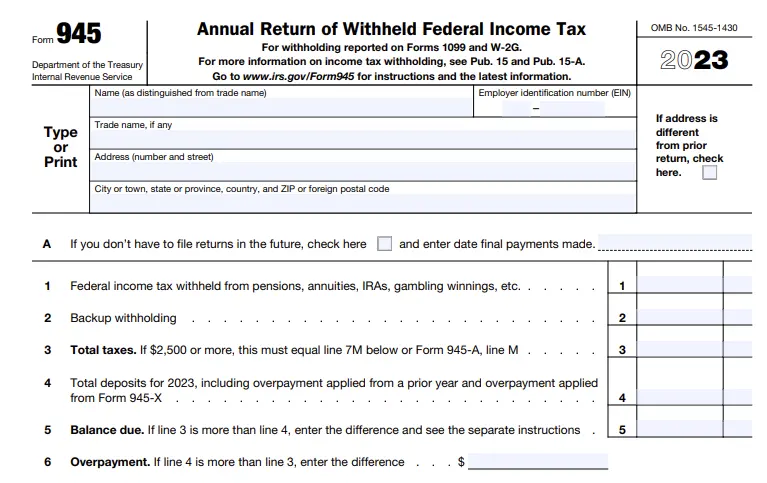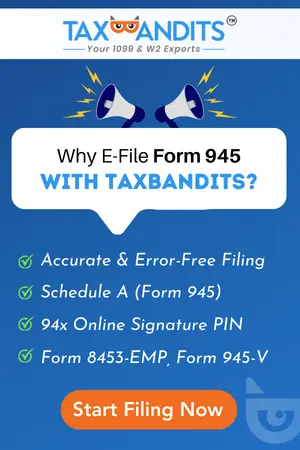The IRS Form 945 - An Overview
Updated on January 23, 2024 - 10:30 AM by Admin, TaxBandits
There are many IRS tax forms due to the IRS at the end of the year, so businesses have a lot on their plate in terms of filing requirements. While business owners are well aware of Form W-2, 1099, and even 941, Form 945 is filed less often, and it’s easy to forget the specifics of this form.
This is a refresher on all things Form 945. From who needs to file it to how to file and when, keep reading for a full breakdown of Form 945.
The following topics are covered in this article:
1. What is Form 945?
The IRS requires that businesses report all federal income tax withholding from non-payroll payments on Form 945.
Some examples of non-payroll payments are pensions, IRS distributions, military retirement, gambling winnings, certain government payments where the recipient opted for voluntary income tax withholding, and any payments subject to backup withholding.
2. Who should file Form 945?
Essentially, any business that has withheld or was required to withhold federal income tax from a payment that was made outside of their payroll should file Form 945. Businesses are only required to file Form 945 if they have non-payroll tax liability during the tax year. If no non-payroll payments were made during the tax year, there is no need to
file Form 945.
3. What are the requirements and instructions for filing 945 Form?
Form 945 has a total of seven lines. After entering the basic business information such as the name, address, and EIN of the business, filers can indicate if they are filing a final return. If so, they should enter the date and amount of the final payments.
-
Line 1
Enter the total amount of federal income taxes withheld from non-payroll payments.
-
Line 2
Enter any backup withholding that the business withheld during the tax year.
-
Line 3
Enter the total taxes. This can be found by adding the amounts on line 1 and line 2. If this amount is more than $2,500 then it should be the same amount as line 7M which comes later on the form. If you are required to complete Form 945-A for semiweekly depositors, this must match up with the amount entered line M.
-
Line 4
Enter the total deposits for the year. Be sure to include any overpayment from Form 945-X.
-
Line 5
Enter the balance due. There is usually only a balance due if the amount on line 3 is less than $2,500.
-
Line 6
You will enter the overpayment amount if applicable. If the amount on line 4 is greater than the amount on line 3, enter the difference here. You can choose a refund for this amount, or the IRS will credit it towards your next return.
-
Line 7
You will need to enter the monthly tax liability amount in boxes A-L and enter the total amount for the year in box M.
If you are a semiweekly depositor, skip this section. You are required to attach Form 945-A instead.
Now all that you have to do is sign and date the form. If you have a third-party designee or are using a paid preparer, they will need to sign the form as well.
4. When is the deadline to file 945?
The Form 945 for the 2023 tax year will be due to the IRS on January 31, 2024. When the deadline falls over a weekend or on a holiday, the next business day becomes the deadline. Any deposits should be made using Electronic Funds Withdrawal (EFW).
5. Are there any penalties for Form 945?
There are penalties and interest accrued for late filing and payment of deposits if you can’t prove that you had a reasonable cause. If you get a penalty notice from the IRS, you should respond by providing an explanation of why the form was filed late.
6. How to e-file Form 945 with TaxBandits?
Form 945 is the Annual Record of Federal Tax Liability. This form should be completed by semiweekly schedule depositors. This form must also be completed by any business that accumulates $100,000 of tax liability during any month of the tax year. The semiweekly depositor must enter their tax liability for each day of the month for the entire tax year. Please note that the total from line M on Form 945-A must match the amount on line 3 of Form 945.
When it comes to filing Form 945, e-filing is the easiest and most convenient option. To begin filing Form 945 with TaxBandits, follow these simple steps:
- Click "Start New Form" and choose Form 945
- Enter the “Form details”
- Review and transmit to the IRS

